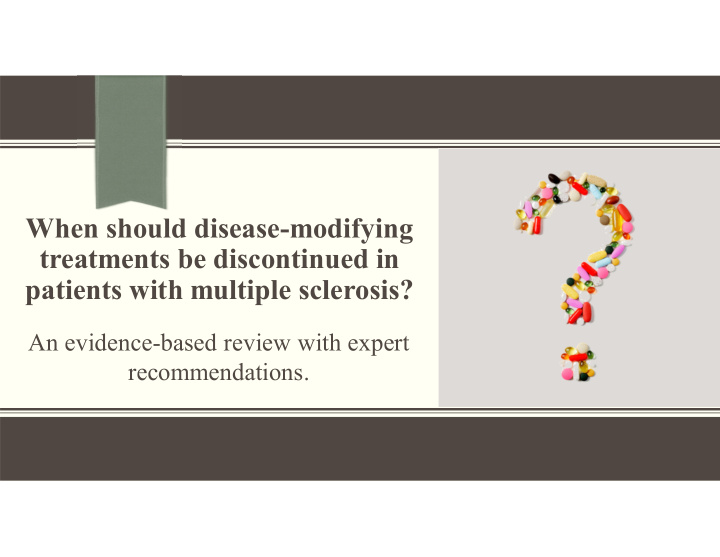



When should disease-modifying treatments be discontinued in patients with multiple sclerosis? An evidence-based review with expert recommendations.
Learning objective To understand the factors relevant to the decision of whether a patient should continue or discontinue their disease modifying treatment. To understand the circumstances in which discontinuation of disease modifying treatment is reasonable to consider.
Background and Rationale Disease modifying therapies (DMTs) are known to modify relapse rates and progression of disability early in relapsing remitting multiple sclerosis (RRMS). However, it remains unknown whether DMTs continue to be effective… Late in the course of relapsing remitting MS In older patients In secondary progressive MS Objective: To review the literature relevant to discontinuation of DMTs, and to provide guidance on when DMTs may be discontinued.
Methods MEDLINE, EMBASE, and the Cochrane Database of Systematic Reviews (current to June 2016) Search terms : Multiple Sclerosis, Disease Modifying Treatments, treatment withdrawal, stopping medication, medication withdrawal Additional articles were identified from reference lists, review articles and recommendations of experts in the field Classification of evidence : American Academy of Neurology guidelines
Discontinuation of DMTs There have been no published randomized controlled trials investigating treatment discontinuation in MS. Several observational studies have suggested a return to baseline disease activity following discontinuation of interferon-beta (Wu et al. , 2005; Siger et al., 2011) or natalizumab (O’Connor et al., 2011; Prosperini et al. , 2015) Other observational studies included older patients with no disease activity on DMT for several years, and suggested positive outcomes for these patients upon DMT discontinuation (Olival et al. , 2013; Kister et al. , 2015; Kister et al., 2016)
Discontinuation of DMTs – Olival et al., 2013 Prospective study of 40 patients who discontinued DMTs after minimum 5 years of continuous use of a single DMT without new disease activity Specific DMTs were not reported At 46 month follow-up… 90% remained free of clinical attack 85% had stable MRIs
Discontinuation of DMTs – Kister et al., 2015 303 patients (age 40+ years) who discontinued DMTs after minimum 3 years continuous use of a single DMT, with no clinical relapses in the past 5 years. Majority of patients resumed DMT use due to an increase in disease activity following discontinuation. 25% reduction in rate of restarting DMT for every 10 year increase in age.
Discontinuation of DMTs – Kister et al., 2016 485 patients (median age 45) discontinued DMT after minimum 3 years of treatment with a single DMT and no clinical relapses in the previous 5 years. 854 propensity-score matched individuals continued DMT Mean annualized relapse rates and time to first relapse were similar for those who discontinued DMT (0.27, 1.81 years) and those who continued (0.25, 2.01 years). Survival time to confirmed disability progression was shorter among those who discontinued DMT. 25% reduction in relapse risk ratio for every 10 year increase in age
Discontinuation of DMTs Independent predictors of remaining free of clinical relapse following discontinuation of DMT for patients with RRMS (Bsteh et al ., 2016): Age >45 yrs Absence of clinical relapses for 4 years prior to discontinuation Absence of contrast enhancing lesions Increasing age is associated with decreased likelihood of clinical relapse following discontinuation of DMT for patients with SPMS (Birnbaum, 2017) Two thirds of patients who discontinued natalizumab experienced clinical relapse, compared to one third of patients who discontinued first-line DMTs (Fagius et al. , 2017)
Rebound syndromes Several observational studies have reported a rebound syndrome following discontinuation of natalizumab. Miravelle et al. , 2011; Rasenack and Derfuss, 2016; Sorensen et al. , 2014; Lo Re et al. , 2015; Salhofer-Polanyi et al. , 2014; Gueguen et al. , 2014 Several randomized trials and observational studies have demonstrated a return to previous disease activity levels following natalizumab discontinuation, without rebound activity. Kaufman et al. , 2015; Stüve et al. , 2009; O’Connor et al. , 2011 Fingolimod discontinuation has been associated with rebound activity in case studies/series. Ghezzi et al. , 2013; Hakiki et al. , 2012; Havla et al. , 2012; Beran et al. , 2013; Sempere et al. , 2013; Alroughani et al. , 2014; La Mantia et al. , 2014; Masuda et al. , 2014; Berger et al. , 2015; Faissner et al. , 2015; Davion et al. , 2016; Hatcher et al. , 2016
Natural history Disease activity in MS decreases with increasing patient age, with fewer clinical relapses and fewer new MRI lesions. (Tremlett et al. , 2009; Confavreux et al. , 2003; Kalincik et al. , 2013) Relapses have less impact on disease progression with greater time from disease onset (Tremlett et al. , 2009)
Safety and adverse effects DMTs are associated with side effects and more serious adverse effects. A potential safety risk of natalizumab and dimethylfumarate is progressive multifocal leukoencephalopathy. No DMTs have been confirmed as safe for use in pregnancy or breastfeeding
Proposed discontinuation guidelines Discontinuation of DMTs is reasonable under the following circumstances: 1. Patients with SPMS who have ongoing progression and no new brain or spinal MRI lesions during the prior 12-24 months. 2. Patients with stable RRMS, age ≥65 years, who have had no new brain or spinal MRI lesions during the prior 12-24 months. 3. Patients with stable RRMS, age 55-65 years, who have had no new brain or spinal MRI lesions during the prior five years. 4. Patients who are pregnant, trying to conceive or breastfeeding.
Further directions Randomized controlled trial of discontinuation of DMTs in a low risk patient population Patients with stable relapsing remitting multiple sclerosis who are greater than 55 years of age, and have had no new brain or spinal MRI lesions during the previous five years.
Acknowledgements I’d like to acknowledge the involvement and support of the following people: Dr Tony Traboulsee Dr Robert Carruthers Dr Virginia Devonshire Dr Lorne Kastrukoff Funding : UBC MS Connect Education Program The Christopher Foundation Contact: devyn.e.parsons@gmail.com
Recommend
More recommend